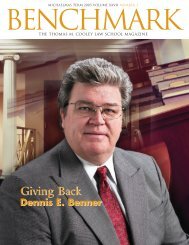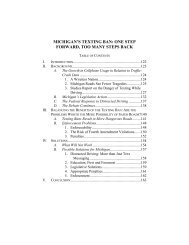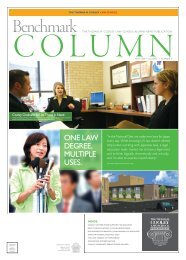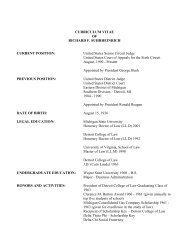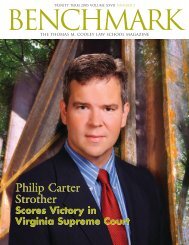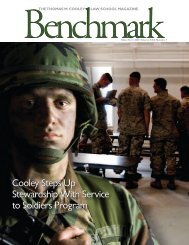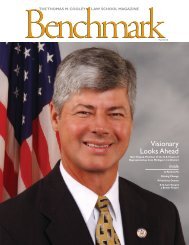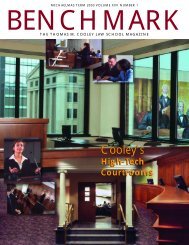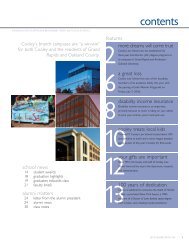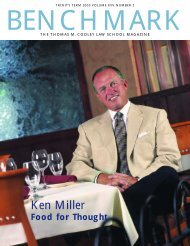Beyond The Model Rules - Thomas M. Cooley Law School
Beyond The Model Rules - Thomas M. Cooley Law School
Beyond The Model Rules - Thomas M. Cooley Law School
You also want an ePaper? Increase the reach of your titles
YUMPU automatically turns print PDFs into web optimized ePapers that Google loves.
596 THOMAS M. COOLEY LAW REVIEW [Vol. 26:3Voluntary, aspirational creeds created by the professionalismmovement represent a step in the right direction. Such creeds aim to evokechange from within the system, by appealing to each individual lawyerthrough persuasion rather than through fear of censure brought about by acomplex legal framework. <strong>The</strong>se types of standards aim to inspire theindividual’s conscience. In practice, however, such creeds often miss theirmark. This Article attempts to appeal to the individual lawyer through anindividual role model. To understand why the use of a role model is a moreeffective source of personal inspiration and guidance than codes andcreeds, this Article will first consider the ideas of Aristotle. Althoughmany critics may deem such an ancient figure irrelevant to today’s lawyerand the present ethical quandary, Aristotle conceived what many believe tobe the first treatise on ethics known to the Western world. 23 A briefconsideration of Aristotle will help achieve a bird’s-eye perspective—amacro, forest-through-the-trees vision that seems missing in hypertechnicaldebates about today’s professional standards.A key component of Aristotle’s teachings is the argument that peopleare not ultimately inspired by laws or institutions but by other people. 24Following this insight, this Article presents Abraham Lincoln, a lawyer—asopposed to Abraham Lincoln, the sixteenth President of the UnitedStates—who acted on his own conscience. Although such a figure may notappear to be the ethical attorney par excellence, this Article attempts toillustrate why he is an ideal choice. This is not to suggest that Lincoln needbe mirrored to achieve ethical balance; there are many ways of being anethical lawyer, just as there are many ways of being an ethical person.Rather, this Article offers Lincoln, the lawyer, as a figure worth observing,studying, reflecting upon, and drawing inspiration from. By studying howLincoln found his own solutions to his ethical crises, lawyers can follow inLincoln’s footsteps as they address their own ethical quandaries.To help review Lincoln’s appraisal of ethical problems within hispractice, and to link his solutions to these problems with contemporarypractice, this Article will juxtapose Lincoln’s actions and decisions withthree especially important <strong>Model</strong> <strong>Rules</strong>. Features of Lincoln’s practice willbe examined in light of <strong>Model</strong> <strong>Rules</strong> 1.1 and 1.3, dealing with competenceand diligence, and <strong>Model</strong> Rule 1.5, dealing with fees. Lincoln, without theguide of any regulation, not only complied with these rules but aspiredbeyond them. Despite the obvious fact that Lincoln practiced law morethan 150 years ago, this Article will show that his ethical aspirationprovides a powerful model for twenty-first-century lawyers.23. LAWRENCE C. BECKER & CHARLOTTE B. BECKER, A HISTORY OF WESTERNETHICS 23-25 (2008).24. See infra text accompanying note 87.



